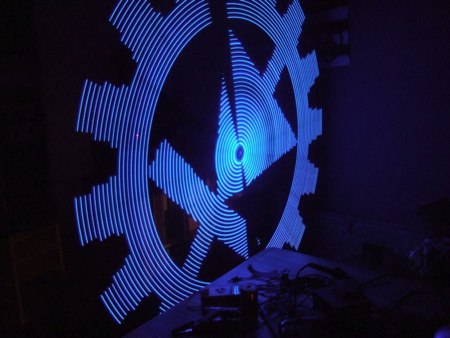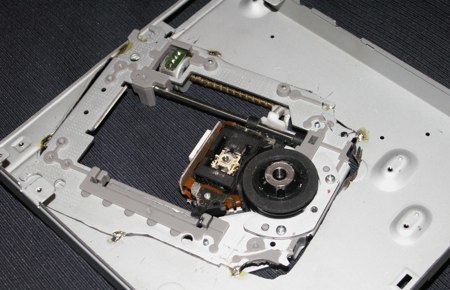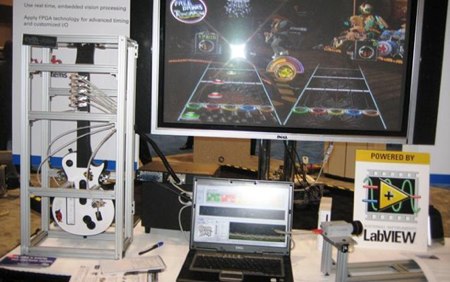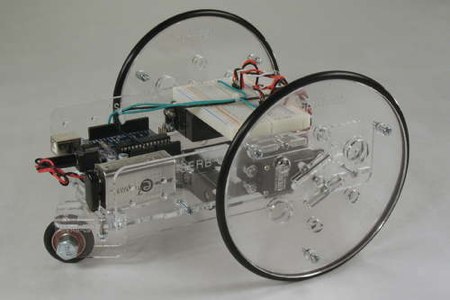Stupidly huge POV display

[Mario Mauerer] and friends were commissioned to build this 2m persistence of vision display (translated) for a party (in a hight-voltage lab no less). Dubbed “Display from Hell”, it uses 100 blue SMD LEDs to generate the POV images. They’re connected to an ATMega64 via shift registers. Their target speed is 600rpm for a flicker free image, which means the propeller tips are moving at 140mph. The board can be updated wirelessly via IRDA and plans for adding SD storage are in place. You have to see and HEAR this thing in the video embedded below.

Slot loading Xbox 360

File this one under: “Wow, that’s even possible?” xbox-scene hacker [RDC] has been hard at work converting his Xbox 360 to slot loading. To start, He removed the slot loading drive from a blueberry iMac G3. The loading mechanism is the top half of the drive. He split this off and married it to the reading mechanism in the Xbox’s Hitachi drive. The difficult part came with getting the drive to properly signal when it had a disc. He put together a custom circuit to do the detection and has a thorough description of how he solved the problem.
[Thanks, bic]

Tennis ball fetcher

Reader [Julian von Mendel] and his team built this tennis ball fetching robot for a competition (translated). The first version used distance sensors to locate the tennis balls for pick-up, but they changed to a camera based approach. The robot has three omniwheels and is designed to calculate the shortest path to the ball despite orientation since it can rotate while traveling. The wheels are monitored using rotation sensors from PS/2 mice. The control is provided by 3 Atmel microcontrollers that communicate via SPI. The multiprocessor design is fairly generic and could be reused for a different style of robot. While their robot performed fairly well, there were some shortcomings. The limited storage space meant frequent trips to drop off balls. The tilting bucket kept them from picking up tennis balls that were against the wall. Also, the bot had to be disassembled for battery swaps. The project is very well documented and they’ve released all of their control code. You can see the robot retrieving a ball after the break.

CCFL bike wheel lights

We’d never discount the beauty that is the SpokePOV bike wheel kits, but if you want to just turn your bicycle into a blinding blur, [depotdevoid] has the solution for you. He had a CCFL tube left over from an abandoned LCD monitor backlight repair, and decided to see what it would look like as a wheel light. The result turned out fairly well. He had to figure out how to mount the 8 batteries plus step-up board. He says the extra weight isn’t really noticeable and the light output is quite bright. CCFLs can be incredibly fragile, so take care when you do the actual mounting.

Cythbot, pneumatic Guitar Hero

Here’s yet another robot hoping to dominate the human race through the power of ROCK. Cythbot was built to demonstrate Cyth Systems machine vision systems. The device uses a camera to watch the Guitar Hero monitor and identify notes for button presses. The strum bar is then triggered after a delay. The notes are identified solely by pixel intensity since star power can cause them to change shape and color. All button presses are done using pneumatics. The whole system is self-contained and doesn’t require a separate computer for processing. Our favorite part is that the controller remains completely unmodified and the industrial light tree used to indicate notes. The team says that the pneumatics aren’t quite fast enough to hit 100%, unlike some humans. Video of the bot in action after the break.
[via Joystiq]

Simple servo bot plans

oomlout has posted some interesting plans for a simple robot. It’s based around an Arduino and is a platform similar to the Parallax Boe-Bot. The Arduino sends PWM signals to continuos rotation servos that drive the two main wheels. All of the structural components are laser cut from acrylic with slots to hold standard hex nuts. It’s an interesting technique, but the design has a lot of potential for improvement. Right now it uses two different power supplies and a breadboard for simple connections. From the video below, you can see that the balance could be improved as well.

You received this email because you are subscribed to the real_time feed for http://hackaday.com/feed/. To change your subscription settings, please log into RSSFWD.




 Sure you could probably pick up a pleather case for nearly any electronic device you own, courtesy of eBay and healthy international trade routes, but it would lack the charm of a hand crafted leather case. There is an excellent tutorial over at the DIY blog Instructables on how to make a molded leather case. The tutorial details how to make the case for an iPod, but the molding technique is valid for anything you'd like to mold a case for. The required tools are minimal and inexpensive, for their sample they bought leather scraps off eBay and made their mold out of dense chipboard and tape. For other interesting DIY case ideas, check out
Sure you could probably pick up a pleather case for nearly any electronic device you own, courtesy of eBay and healthy international trade routes, but it would lack the charm of a hand crafted leather case. There is an excellent tutorial over at the DIY blog Instructables on how to make a molded leather case. The tutorial details how to make the case for an iPod, but the molding technique is valid for anything you'd like to mold a case for. The required tools are minimal and inexpensive, for their sample they bought leather scraps off eBay and made their mold out of dense chipboard and tape. For other interesting DIY case ideas, check out  What happens when something that was once a special treat, slowly becomes an expected part of your daily routine? Trent, over at frugality blog The Simple Dollar, noticed that things he had previously done as a treat of sorts had become necessary components of his day much to the detriment of his wallet. Describing how his enjoyment of the a local coffee shop had changed:
What happens when something that was once a special treat, slowly becomes an expected part of your daily routine? Trent, over at frugality blog The Simple Dollar, noticed that things he had previously done as a treat of sorts had become necessary components of his day much to the detriment of his wallet. Describing how his enjoyment of the a local coffee shop had changed: Over at design blog Web Design Ledger, they've rounded up over two dozen tutorials to teach you how to add impressive lighting effects to your photos. Whether you want to inject some sparkles, motion trails, sun flares, fire, star bursts or luminescence into your image, there is a tutorial for you. Completely new to Photoshop?
Over at design blog Web Design Ledger, they've rounded up over two dozen tutorials to teach you how to add impressive lighting effects to your photos. Whether you want to inject some sparkles, motion trails, sun flares, fire, star bursts or luminescence into your image, there is a tutorial for you. Completely new to Photoshop?